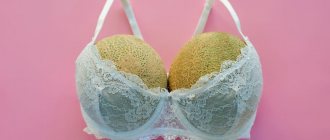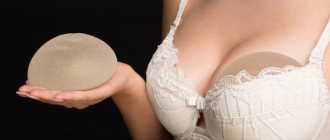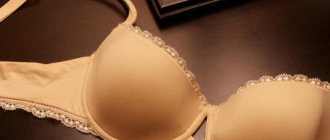How and when breast growth begins and when mammary gland development stops is a question that is asked, perhaps, not only by teenagers, but also by adult women.
The formation of mammary glands is an important stage in the transformation of an ordinary girl into a beautiful girl. This period is associated with a number of physiological changes. In modern society, increased importance is placed on female beauty, and in particular, breasts, so it is so important to know how breasts grow, what to do if the mammary glands do not enlarge, and how to influence breast growth.
Perhaps many people remember that in one of the interviews Anna Semenovich, the owner of an impressive bust, admitted that she ate a lot of cabbage as a child, which is why she now has such outstanding forms. In the article we will talk about how breasts grow: the stages of development and how to influence them, and we will also talk about alarming points that you need to pay attention to during this period.
Stages of female breast development
Changes in the appearance of girls' breasts begin at puberty. As soon as estrogens—female sex hormones—begin to form, the slow, and in some cases faster, growth of the mammary and endocrine glands begins.
This stage is individual for each girl; it is impossible to say clearly in what year and month it will begin, there are only approximate periods.
So, there are several periods of formation of the mammary glands, these are:
- From birth until the age of ten years. At birth, the mammary glands of infants of different sexes do not differ, except that in some cases girls experience a certain amount of discharge from the papillae, which is not a disease and does not last long. By the age of ten, girls may have a noticeable milk line and a slightly roughened nipple;
- The second stage conventionally begins at the age of 12 and lasts until the age of 13; during this period of time, changes in the mammary glands of girls are already noticeable, namely: the areola darkens slightly and the glandular tissue can be felt under it, the breast becomes softer, and the nipple itself enlarges. A characteristic feature of this period is some swelling in the area around the nipple;
- Puberty period, which lasts about one and a half years, from about 13 to 14.5 years. This point in time is characterized by strong hormonal changes, which end by the end of the period, and active growth of the mammary glands. Usually the mammary glands take the shape of a cone, and the papilla becomes more rounded;
- The final period of formation of the mammary glands occurs between the ages of 15 and 16 years, during this period ducts form in the mammary gland, the breasts become rounded, and by the end of the period its growth ends. There may be not very pleasant sensations in the nipple area associated with breast growth.
However, not all girls experience the period of breast growth ending by the age of 16; for many it occurs by the age of 18-20. As a rule, this breast shape lasts until 25-27 years of age or until pregnancy.
How much do breasts grow during pregnancy?
During pregnancy, breasts increase by 1–3 sizes. Weight gain will range from 150 to 900 g. Certain changes occur in each trimester:
- 1st trimester. A woman notices an increase in glands by 1 size. This occurs due to increased tissue growth and the formation of additional milk ducts. The changes may not be noticeable from the outside, but the pregnant woman feels swelling, increased elasticity and tightness of the skin. In some expectant mothers, breast weight already reaches 400–700 g by 3–4 weeks (more details in the article: at what stage of pregnancy do breasts begin to swell and can this condition be painful?).
- 2nd trimester. The expansion of the ducts reaches a maximum, the growth of glandular tissue gradually slows down.
- 3rd trimester. Due to the increase in the volume of glandular tissue, the skin stretches, which leads to itching. The breasts begin to grow again from 31–32 weeks, when colostrum is actively produced, and gain maximum weight at the time of birth.
Mammary glands: beginning and completion of development
When discussing how breasts grow: stages of development and how to influence them, you need to understand that there is no clear framework for a particular period.
So, in some girls, the mammary glands can change by the age of 9, while in others - only by the age of 14. The process of the beginning of mammary gland growth is influenced by heredity, lifestyle and physique characteristics, as well as sports.
As a rule, by the age of 16, girls turn into girls with a feminine silhouette and clear breast contours.
Doctors agree that, in general, breasts grow within four years from the start of menstruation. After the period of breast growth is completed, the body is ready for reproductive functions.
Anatomical structure of the organ
The mammary gland is a secondary sexual characteristic that develops in all female mammals. In mature women, the glands form two symmetrical elevations that are adjacent to the anterior chest wall (between the 3rd and 7th ribs). On the surface of the breast is a nipple surrounded by an areola. The mammary gland itself is a dense body in the shape of a convex disk. It is surrounded by a layer of fatty tissue and is literally “attached” to the body with the help of muscles. The organ is supplied with blood through the internal and lateral mammary arteries.
Content:
- Anatomical structure of the organ
- Mechanism of breast swelling
- Possible causes of breast enlargement
- In what cases is it necessary to consult a doctor?
- Do I need to examine my breasts myself?
Throughout life, a woman's breasts undergo cyclical changes. They are closely related to the menstrual cycle and the body’s preparation for fertilization. Before menstruation begins, the mammary glands swell and become more sensitive, and the nipple and areola may change color slightly. If fertilization does not occur, the balance of hormones is restored, sensitivity disappears, and the breasts return to their usual size.
Puberty: all physiological changes
The main growth of breasts occurs during puberty, which is so famous for its intolerable character. However, breast enlargement at this moment is not the only change in the body of the future woman.
Girls aged 13.5-15 years old face such phenomena as:
- Presence of sweating;
- The appearance of hair in the armpits and pubic area;
- The appearance of menstruation;
- The hips are rounded or enlarged.
All changes during the period of mammary gland growth are associated with the endocrine system, which is why consulting a doctor is so important.
It happens that the endocrine system malfunctions, and the girl begins to quickly gain weight, or, on the contrary, her hips become too wide or her legs become fat. It can be very difficult to lose weight later; the teenager is subjected to severe psychological shock, which is why it is so important to visit an endocrinologist.
Contraceptives
At the time when birth control pills were first invented, they contained a very high dose of estrogen, so a large number of women could boast of a large bust. Modern drugs contain only 1/5 of the estrogen that was before, so the breasts increase slightly. However, it is completely normal if, after starting to take the pills, you feel that your previous bra has become too small for you, and your breasts have become more sensitive.
What affects breast growth
Of course, we are always interested in the question of why some women have rich breasts, while others have to resort to tricks in order to somehow prove the presence of a bust.
Continuing the topic of how breasts grow: stages of development and how to influence them, we will consider all the factors influencing breast size, namely:
- The criterion of heredity is one of the main ones in the issue of breast size. It would be good to have an approximate idea of what kind of bust all your close relatives had, this will help determine your future breast size;
- The amount of hormones, namely the hormonal background, is also responsible for the size of the future bra. If there is a lack of female hormones in the body, then the mammary glands may not reach the desired size;
- Nutrition is also responsible for breast volume. If the diet is poor and lacks the necessary nutrients, then you won’t have to count on large breasts even with good heredity;
- Exercising affects the firmness of the breast rather than its size. Although, if girls are engaged in professional ballet, their diet is designed in such a way as to avoid the appearance of curvy figures;
- Ecology is also not in last place when it comes to breast formation. In areas with poor environmental conditions, girls not only will not have to count on normal breast growth, but there is also a high likelihood of health problems;
- Belonging to certain races is also important. Thus, southern women have more curvaceous figures, their breasts are already formed by the age of 12, while northern women are just beginning puberty by this time.
Menopause
Since breasts are a part of your body that is extremely dependent on hormone levels, their size may become less prominent during menopause due to low estrogen levels. Breasts may also become larger because during menopause a woman engages in less physical and sexual activity, which allows fatty tissue to grow.
Unfortunately, because many women gain weight during menopause, they are at greater risk of developing cancer cells than those who lose or maintain weight. That's why you shouldn't forget about fitness, even if you're no longer eager to show off your body on the beach.
Breasts not growing: what to do
It happens that all periods of breast formation have come to an end, and the mammary glands remain barely visible. In this case, there is a high probability that the body has stopped producing the female hormone - estrogen. There is no need to postpone a visit to the endocrinologist.
The doctor may prescribe hormone replacement therapy and will also suggest that you donate not only blood for biochemistry, but also an extensive blood test. In addition, he will prescribe a thyroid examination.
Stopping breast growth threatens not only a small volume in the future, but also a violation of reproductive function.
In what cases is it necessary to consult a doctor?
First of all, determine the nature and cause of the pain. If you have never experienced such sensations, contact your gynecologist. Describe your condition, tell us about the conditions in which it arose. If the doctor finds suspicious symptoms, then you can immediately undergo diagnosis and neutralize the disease in a timely manner. Often, natural swelling of the mammary glands does not cause significant discomfort. The main thing is to be reasonable and learn to listen to your own body.
When to start wearing a bra
Of course, every girl wants to feel like an adult as soon as possible, and use not only lipstick, but also wear underwear, especially since now the choice is huge. As a rule, girls begin to feel discomfort from the age of eight, this applies to their stay on the beach in only panties. They often refuse to swim altogether. In this case, a set of a top and panties or a one-piece children's swimsuit will help.
In everyday life, T-shirts are needed for girls starting from the age of 8, even if there is no hint of breasts yet. In the future, bras in the form of tops, a kind of bras without wires and excessively thin straps, will be an excellent option.
As soon as the girls' breasts develop to the first size, they need a regular, as they say, women's bra. You need to choose it with obligatory fitting in order to make the right choice and avoid such troubles as deformation of the papillae and problems with the mammary glands. Of course, underwear should be made from natural materials.
What determines bust size?2
Don't be under the illusion that your breasts will be the size you dream of. No. First, pay attention to close relatives on the female side. And, if your mother and sister are not the owners of curvy figures, then most likely your breast growth process will follow a similar scenario. The hereditary factor plays a significant role in this matter.
It's no secret that almost all representatives of the fair sex dream of a slim figure. In their dream of it, they exhaust themselves with strict diets, denying themselves almost everything. Remember that the process of losing weight begins with the chest. So, the choice is yours!
Breast enlargement products3
To achieve the desired size, some ladies are ready for various tricks. Domestic and imported creams and nutritional supplements are used. However, no one takes into account the fact that the components of plant origin in such creams, imitating the effect of estrogens, disrupt the natural hormonal balance. Moreover, the cream is applied directly to the mammary gland and exhibits its negative effect directly there. There is a threat of breast tumors of a hormone-dependent nature.
Important! If, despite this, you still decide to use such ointments, monitor your health, visit a mammologist, get tested, and monitor your hormone levels.
A similar picture is with nutritional supplements and tablets, the effect of which directly depends on the sex hormones they contain. When using them, women do not want to understand that these drugs are not only ineffective, since they will never change the size of their breasts in the direction of enlargement, they actually pose a threat to women’s health.
Prosthetics as a way to enlarge breasts4
One of the effective ways to enlarge breasts is prosthetics. But this is far from a safe procedure. And the proverb “measure seven times and cut once” is quite relevant in a situation with such an operation.
Those who, despite the warning, still decide in favor of surgery, should undergo a mammogram and ultrasound of the mammary glands as part of the examination. These examination methods will allow, in the case of the presence of lumps and neoplasms in the breast, to identify them in a timely manner and prevent a dangerous operation in this situation.
Childhood
Childhood is the period of life from birth to 7-8 years. The functions of the ovaries are not yet developed, however, estrogen is already synthesized in small quantities. The uterus is already present in its rightful place, but it is very small in size, even the cervix is much thicker. Fallopian tubes are also present, but they are thin and tortuous, and the lumen is very small. The internal genital organs are not yet sufficiently developed, the mucous membrane is very thin. The external genitalia are fully formed, but there is no hair.
The hypothalamus already produces releasing hormones, which in turn affect the pituitary gland and the production of FSH and LH. Hormonal regulation is gradually being formed, however, the overall production of hormones is still too small1.
If a girl has complexes about her height
A teenager, and especially a girl, can have very strong complexes about their appearance, and height can be one of the reasons.
If a girl develops a complex about the fact that she considers herself too tall, then the task falls on the mother to delicately and tactfully explain to the child that this should not at all be a reason for concern about her appearance. A tall girl was always beautiful and was a passport to the world of models.
It is extremely important to help the girl adequately relate to herself and her external characteristics, and also to learn to live with the idea that it is impossible to slow down or stop growth and there is absolutely no point in doing this.
It is better to switch your preoccupation with your appearance, in the context of growth, to working on establishing beautiful posture and getting rid of stoop. To avoid curvature of the spine.
The article was compiled on the basis of a scientific article: Gribakin S.G. “The importance of sleep for the development of a child” and materials from the work of teachers and educational practice of employees of the Solnyshko Children's Home of the Republic of Kazakhstan domsolnyshko.kz/o-nas/o-detskom-dome/.
Puberty period
Puberty occurs at 16-17 years of age and lasts on average until 45 years of age or the beginning of the perimenopause period. During puberty, also called the reproductive period, most women at this age ovulate regularly. From this age until the end of the reproductive period, a woman is physiologically ready to conceive, bear a child and feed him. Nature has tried and allocated a large period of time for the reproductive period, when a woman can conceive a child.
The next significant changes in the physiology of the female body occur when the effect of sex hormones begins to weaken and sexual function gradually fades3.
Do breasts hurt as they grow?
The growth of any tissue is accompanied by unpleasant pain. This happens for various reasons:
- Taking hormonal drugs stimulates processes in which the mammary gland capsule increases in size. The glandular tissue is stretched, and the connective tissue surrounding it does not have high elasticity. This is why women experience a feeling of tightness in their chest when using some birth control medications.
- As the volume of the bust increases, the skin stretches and hurts.
If the appearance of pain affects the quality of life, it is worth visiting a doctor who has prescribed hormonal medications.











